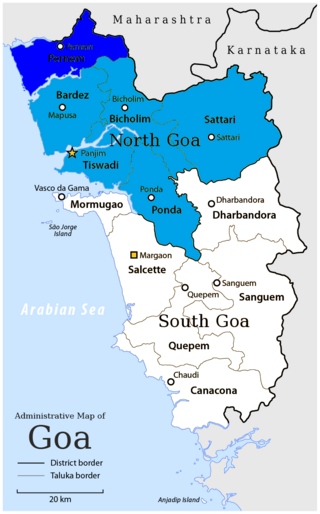
Bardez or Bardes is a taluka of the North Goa district in the Indian state of Goa.

Pernem is a northmost administrative region or sub-district in North Goa in India. It acts as the Gateway of Goa from Maharashtra side. It is also the name of the town of Pernem, which is its headquarters. It has a Municipal Council. Geographically, Pernem is surrounded by Sawantwadi sub-district on East, Arabian Sea on West, Bardez and Bicholim sub-district on south and Sawantwadi sub-district on north. The two rivers which decide the boundary of this sub-district are Terekhol River and Chapora River. Terekhol river acts as a border of Maharashtra and Goa while Chapora river acts as a border of Pernem sub-district and Bardez sub-district.
Aldona is a village that lies in the Bardez taluka of the Indian coastal state of Goa. It is known for producing several prominent Goans personalities.

Mapusa River is one of the main tributaries of the River Mandovi in Goa, India. The river originates from the jungles of Dumacem and Amthane, meanders eastward and then southward before it drains itself in the Mandovi river at Penha de France. Mapusa River has separated Corjuem from mainland Aldona. The Assonora River is the main tributary of Mapusa River. It is situated 12 km from the mapusa city which is a capital of the Bardez taluka and is one of the largest towns of Goa. It flows 20 kilometres in western direction. Penha de Franca church is situated on the junction of the River Mapusa and River Mandovi. Mapusa is the largest town located on the banks of the river.
Parra is a village on the outskirts of Mapusa town Bardez sub-district, North Goa, India. It has traditionally been known as a village that has grown luscious watermelons. In recent times, the village is facing considerable urbanisation and social change.
Cunchelim or Kucheli is a village in Bardez taluka, in the district of North Goa, in the state of Goa in India.

Fort Assunção or Corjuem Fort is a fortress situated 4 kilometres (2.5 mi) from the village of Aldona on the river island of Corjuem, Goa. It was a military fortress for the defense of Portuguese India. It is smaller than the other forts in Goa, but it gives a good view of the surrounding river and land. It is a protected monument under the Goa, Daman and Diu ancient monuments and archaeological sites and remains act.
The Fortaleza de São Sebastião, also called the Tivim Fort, after the village where a part of the long wall structure was once located, is a fort that spans from the village of Tivim, to the area known as Colvale, in Goa, on the west coast of India. Currently, most of it is in ruins and barely visible. However, parts of the structure are in the process of being restored.

Thivim railway station is one of the main railway stations for North Goa at Sircaim. It is part of the North South line and almost every train serves this station.
Verna Railway Station is a railway station in Nagoa – Cansaulim Road, Verna, Salcete, South Goa, Goa.
Loliem Railway Station a railway station in Goa, under the jurisdiction of the Konkan Railway. It's the last railway station in South-West railway zone in the state of Goa in its southern end.
Balli Railway Station is a smaller railway station in Goa, under the jurisdiction of Konkan Railway. It lies is in Balli village off the highway connecting Chandor to Canacona.
Suravali Railway Station is a smaller railway station in Goa.
Assonora is a village located in the Bardez taluka of Goa, India. It is located in North Goa, 12 km (7.5 mi) away from Mapusa and 24 km (15 mi) away from Panaji. The church of Assonora is St Clara's.
The Chorão Epidemic killed over a thousand women, men and children in Chorão, an island along the Mandovi River near Ilhas, Goa, India. It also caused thousands to flee the island, and led to the closure of Real Colégio de Educação de Chorão in 1859. The Epidemic and its after-effects left the island deserted for almost 100 years.

The Maratha–Portuguese War of 1683–1684 or Sambhaji's Invasion refers to the Maratha invasion of the Portuguese-controlled portions of Goa and Bombay areas of Konkan. The conflict between the Mahratta Confederacy and the Portuguese in Goa and Bombay, continued on various fronts in between 1683–1684.
Mughal invasion of Konkan (1684) was a part of the Deccan wars. It was a campaign launched by Mughal Emperor Aurangzeb to capture the Konkan region from the Maratha ruler Sambhaji. The Mughal forces were led by Mu'azzam and Shahbuddin Khan. The harsh climate and the Maratha guerrilla strategy forced the numerically strong Mughal army into a slow retreat. The Maratha army suffered small losses in this unsuccessful campaign of the Mughal Empire.
The siege of Alorna in 1746 was a military engagement that took place in India, between Portuguese forces under the command of the Viceroy of India, Dom Pedro Miguel de Almeida Portugal, and those of the Sawantwadi State then part of the Maratha Confederacy, which were defeated. It was the crowning achievement in the career of Dom Pedro Miguel as Viceroy of India, and as a reward for his services to the Portuguese Crown he was later attributed the title Marquis of Alorna.

Pascoal Tony Fernandes, known professionally as Pascoal de Chicalim, is an Indian playwright, theatre director, theatrical producer, actor, and singer known for his work in Hindi, Konkani films, Marathi nataks, and tiatr productions.









